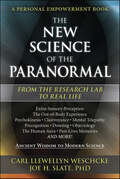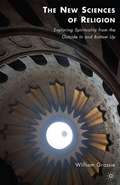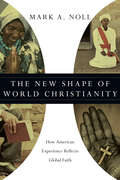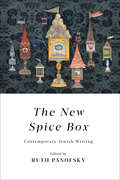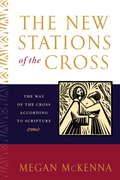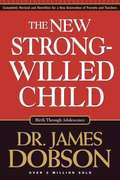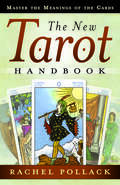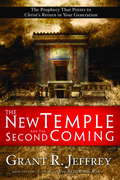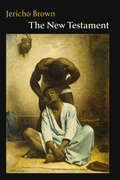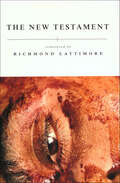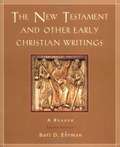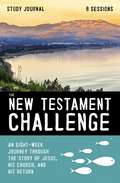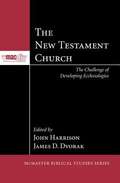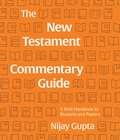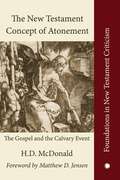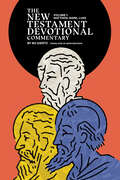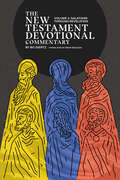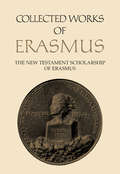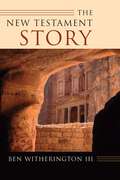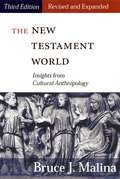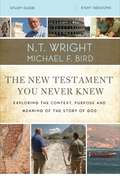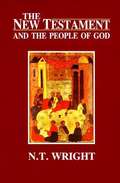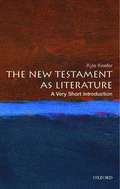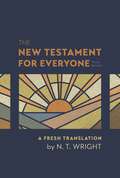- Table View
- List View
The New Science of the Paranormal: From the Research Lab To Real Life
by Joe H. Slate Carl Llewellyn WeschckeUse Scientific Research for Empowerment, Growth, and SuccessSweep illusions away and use your mind for what it was intended: to lift human consciousness to a higher level and make this world a better place for you and future generations. The New Science of the Paranormal is a mind-expanding exploration of the scientific proof for paranormal phenomena and the ways you can use your paranormal potential to take control of your life.Discover a wealth of tools to create a life of greater success and happiness. Through expanding conscious awareness of your inner powers and abilities, you advance into the development of your Super-Conscious Mind where limitations drop away and realization of your most cherished dreams becomes reality.
The New Sciences of Religion
by William GrassiePerforming a critical analysis of new scientific research on religious and spiritual phenomena, Grassie takes a two-staged phenomenological approach working from the 'outside in' and the 'bottom up' without privileging at the outset any religious traditions or philosophical assumptions.
The New Shape of World Christianity: How American Experience Reflects Global Faith
by Mark A. NollChristianity Todayhowwhat
The New Spice Box: Contemporary Jewish Writing
by Ruth PanofskyThe New Spice Box includes short fiction, personal essays, and poetry by Jewish writers from a broad range of cultural backgrounds. Fresh and relevant, profound and lasting, this anthology features works by acclaimed short story writers David Bezmozgis, Mireille Silcoff, and Ayelet Tsabari; groundbreaking memoirists Bernice Eisenstein and Alison Pick; and award-winning poets Isa Milman, Jacob Scheier, and Adam Sol. The driving force behind The New Spice Box is the desire to uncover the twin touchstones of original expression and writerly craft, and to balance the representation of genres, styles, and authorial perspectives. Here, authors summon the past as they probe their cultural inheritance and move forward into the future. The New Spice Box shows that Jewish literary tradition, Jewish experience, and Jewish identity can be expressed in innumerable ways.
The New Stations of the Cross
by Megan MckennaOne of today’s most popular and respected Catholic writers presents the first guide to the new Stations of the Cross, reflecting the revisions made by Pope John Paul II. A traditional devotion for Catholics for more than four hundred years, the Stations of the Cross commemorates the route Jesus traveled from being sentenced to death, crucified, and then buried in a borrowed tomb on the outskirts of Jerusalem. In the past, the devotion included a number of stations based on popular stories of piety and devotion, but not mentioned in the Gospels. Over the past eight years, however, Pope John Paul II has made substantial changes to the devotion in his Good Friday celebrations of the stations, removing those not found in the Bible and replacing them with stations that more accurately follow scriptural accounts of Christ’s passion. The revised Stations of the Cross focuses on the condemned Jesus and on the community walking the way with him to the cross. Unrelieved by stories like Veronica’s wiping blood off the face of Jesus and his meeting with his mother; this is a story of an execution. The new stations deal directly with the pain, suffering, betrayal, and injustice to which Jesus was subjected. In explaining his reasons for revising the stations, the Pope has said that the alterations are intended to serve as a model for other devotions and to encourage the return to the Scriptures as the source of and inspiration for contemporary worship. In this helpful, authoritative guide, Megan McKenna presents the fourteen new stations with the scriptural passages that Pope John Paul II uses on Good Friday. She also provides a basic introduction to the practices and reflections on the importance of the devotion for present-day Catholics and Episcopalians.
The New Strong-willed Child: Birth Through Adolescence
by James Dobson2005 Gold Medallion Award finalist! Dr. James Dobson has completely rewritten, updated, and expanded his classic best seller The Strong-Willed Child for a new generation of parents and teachers. The New Strong-Willed Child follows on the heels of Dr. Dobson's phenomenal best seller Bringing Up Boys. It offers practical how-to advice on raising difficult-to-handle children and incorporates the latest research with Dr. Dobson's legendary wit and wisdom. The New Strong-Willed Child is being rushed to press for parents needing help dealing with sibling rivalry, adhd, low self-esteem, and other important issues. This book is a must-read for parents and teachers struggling to raise and teach children who are convinced they should be able to live by their own rules!
The New Tarot Handbook: Master the Meanings of the Cards
by Rachel PollackRenowned author Rachel Pollack has spent more than forty years studying and practicing Tarot. This insightful guide distills her vast knowledge and offers a direct, accessible approach to mastering the cards.This book will teach you the meanings of the cards and enable you to begin doing compelling readings right away. More seasoned readers will find that this basic reference has a richness and depth that will call you back again and again to discover your own truth within the cards.Find new descriptions and divinatory meanings with a modern twistLearn not only what each card signifies, but how to discover what it means to youEnhance your understanding of the cards with information about numbers, elements, astrology, and KabbalahTry the unique spreads inspired by each Major Arcana cardUnderstand Tarot's rich history, including Eden Gray's immense influence
The New Temple and the Second Coming: The Prophecy That Points to Christ's Return in Your Generation
by Grant R. JeffreyAn array of new archaeological finds and revealing discoveries in the ancient city hidden beneath Jerusalem lead to a stunning conclusion: The generation alive today will witness the return of Christ.The evidence-uncovered by prophecy expert Grant R. Jeffrey-is breathtaking: Jewish authorities are preparing to rebuild the Temple in Jerusalem. Quietly they have recovered lost artifacts from the ancient Temple and have recreated sacred worship vessels. The new Sanhedrin, now reconvened in Israel, is training Levite priests to reinstitute animal sacrifice. These remarkable developments have far-reaching prophetic significance. In this book you will examine the biblical prophecies and research data that together solve end-times mysteries, including:·The search for lost Temple treasures ·Revealing discoveries in underground Jerusalem·The process of recreating sacred Temple vessels ·Unexpected clues revealed in the Copper Scroll and the Ezekiel Tablets·The latest plans for rebuilding the TempleJoin Dr. Jeffrey as he uncovers answers to questions that have perplexed students of prophecy for centuries. Answers that point to the unmistakable conclusion that this is truly the last generation.From the Trade Paperback edition.
The New Testament
by Jericho BrownHonored as a "Best Book of 2014" by Library Journal <P>In his second collection, The New Testament, Brown treats disease and love and lust between men, with a gentle touch, returning again and again to the stories of the Bible, which confirm or dispute his vision of real life. <P>In the world of Jericho Brown's second book, disease runs through the body, violence runs through the neighborhood, memories run through the mind, trauma runs through generations. Almost eerily quiet in even the bluntest of poems, Brown gives us the ache of a throat that has yet to say the hardest thing--and the truth is coming on fast. <P>ericho Brown worked as the speechwriter for the mayor of New Orleans before earning his PhD in creative writing and literature from the University of Houston. His first book, PLEASE (New Issues), won the American Book Award. He currently teaches at Emory University and lives in Atlanta, Georgia.
The New Testament
by Richmond LattimoreRichard Lattimore, among the most distinguished translators of the Greek classics, concluded late in his life one of his most ambitious projects - a complete translation of the New Testament. This New Testament is itself a classic of another kind - the words of the gospel and the apostles presented for the modern reader in fresh English by a writer without pretensions as a biblical scholar, who was an authority on the Greek language in which these texts have come down to us.
The New Testament And Other Early Christian Writings: A Reader
by Bart EhrmanThe twenty-seven books of the New Testament were not the only writings produced by early Christians. Nor were they the only ones to be accepted, at one time or another, as sacred Scripture. Unfortunately, nearly all the other early Christian writings have been lost or destroyed. But approximately twenty-five books written at about the same time as the New Testament have survived--books that reveal the rich diversity of early Christian views about God, Jesus, the world, salvation, ethics, and ritual practice. This reader presents, for the first time in one volume, every Christian writing known to have been produced during the first hundred years of the church (30-130 C.E.). In addition to the New Testament itself, it includes other, noncanonical Gospels, Acts, Epistles, and Apocalypses, as well as additional important writings, such as those of the Apostolic Fathers. Each text is provided in an up-to-date and readable translation (including the NRSV for the New Testament), and introduced with a succinct and incisive discussion of its author, date of composition, and overarching themes. This second edition adds The Martyrdom of Polycarp, an important text that will enhance the collection's utility in the classroom. It also features Ehrman's new, accessible translations of many of the noncanonical works and provides updated introductions that incorporate the most recent scholarship. With an opening overview that shows how the canon of the New Testament came to be formulated--the process by which some Christian books came to be regarded as sacred Scripture whereas others came to be excluded--this accessible reader will meet the needs of students, scholars, and general readers alike. An ideal primary text for courses in the New Testament, Christian Origins, and Early Church History, it can be used in conjunction with its companion volume, the author's The New Testament: A Historical Introduction to the Early Christian Writings, 3/e (OUP, 2003).
The New Testament Challenge Study Journal: An Eight-Week Journey Through the Story of Jesus, His Church, and His Return
by Jeff ManionThe New Testament Challenge is designed to help small-group members explore the books of the New Testament in a fresh and new way. In this Bible study (DVD/digital downloads sold separately), participants will learn how the story of God restoring his original creation—which was begun in the Old Testament—reached its crowning moment with the birth of Messiah into the world. Through Jesus' birth, he answered the question once and for all of who God is and what he is like. Through Jesus' teaching, he revealed the deepest meaning of the laws and institutions that God gave to the people of Israel. Through Jesus' death and resurrection, he introduced the life of the age to come into the present age. Group members will also discover how the followers of Jesus formed a new community and invited people from all over the world to join them, and how the Bible looks ahead to the day when Christ will return to renew all of creation and establish God's justice and peace on the earth.Sessions include:Luke–ActsLuke–Acts, 1–2 Thessalonians1–2 Corinthians, Galatians, RomansRomans, Colossians, Ephesians, Philemon, Philippians, 1 Timothy, Titus, 2 TimothyMatthewHebrews, James, Mark1–2 Peter, Jude, John1–3 John, RevelationDesigned for use with The New Testament Challenge Video Study (sold separately).
The New Testament Church: The Challenge of Developing Ecclesiologies (McMaster Divinity College Biblical Studies Series #1)
by John P. Harrison James D. DvorakChristian communities today face enormous challenges in the new contexts and teachings that try to redefine what churches should be. Christians look to the New Testament for a pattern for the church, but the New Testament does not present a totally uniform picture of the structure, leadership, and sacraments practiced by first-century congregations. There was a unity of the Christian communities centered on the teaching that Jesus is the Christ, whom God has raised from the dead and has enthroned as Lord, yet not every assembly did exactly the same thing and saw themselves in exactly the same way. Rather, in the New Testament we find a collage of rich theological insights into what it means to be the church. When leaders of today see this diversity, they can look for New Testament ecclesiologies that are most relevant to the social and cultural context in which their community lives. This volume of essays, written with the latest scholarship, highlights the uniqueness of individual ecclesiologies of the various New Testament documents and their core unifying themes.
The New Testament Commentary Guide: A Brief Handbook for Students and Pastors
by Nijay GuptaAn indispensable map to the often intimidating world of biblical commentaries. For many beginning students of the New Testament, looking for a commentary seems like a simple process: identify the book you're studying, search for a commentary, and pick one. However, the reality is far from simple. With new commentaries being published every year on every book of the Bible, the student of Scripture can quickly become overwhelmed with an inexhaustible amount of resources. What is the student to do? In this short, accessible resource, Nijay Gupta helps beginning Bible students understand the various available commentaries--their strengths, unique contributions, and ultimately, how to use them. Through The New Testament Commentary Guide, readers will understand how to incorporate commentaries into their learning and be enriched in their study of the Bible.
The New Testament Concept of Atonement: The Gospel of the Calvary Event (Foundations in New Testament Criticism)
by Hd McDonaldFor the Christian faith, questions relating to God can essentially be viewed as centred on the person of Jesus Christ. In The New Testament Concept of Atonement, H.D. McDonald uses this key insight to examine mankind's redemption, focussing on Christ's atoning act as crucial in shaping God's relation to humanity and the world. McDonald analyses elements which hold vital meanings and messages for the Christian doctrine of salvation. In the first six chapters he investigates single terms within the New Testament, such as 'tree' or 'blood' whose metonymical association with Christ's redeeming act has often become obscured over time. Then, various biblical interpretations of the Calvary event are studied. In the final section, he analyses the importance of the findings in previous chapters and their implications for Christology. Detailed research underpins the text, in the tradition of Reformed biblical scholarship, with care taken to suggest further reading and trace sources.
The New Testament Devotional Commentary, Volume 1: Matthew, Mark, and Like (New Testament Devotional Commentaries)
by Bror Erickson Bo GiertzBo Giertz was a serious biblical scholar who avoided the ivory tower. He studied classics in undergrad before taking up theology in preparation for the ministry. In 1930 he spent time on an archeological dig in Palestine and travelled the country with his exegetical professor Anton Fridrichsen who insisted on "Biblical Realism," which avoided fundamentalism and yet refused to succumb to higher criticism. In these commentaries, Bo Giertz takes what he learned from a lifetime of such study and application in in sermons and visits with people to open Scripture to anyone who wants to grow in their faith. He never avoids the hard questions concerning the texts, and yet tackles them in such a way as to restore confidence in God's word. Here, he is concerned with what the text meant to those who first wrote it and heard it so he can deliver the same goods to us today.
The New Testament Devotional Commentary, Volume 3: Galatians through Revelation (New Testament Devotional Commentaries)
by Bo GiertzIn The New Testament Devotional Commentary Volume 3: Galatians Through Revelation, Bo Giertz returns to the text with his keen insight and love for God' s word and God' s people. This would finish his work as an author that began in the 1930s and continued for five decades. Taking the principles of Biblical Realism he had learned from his mentor Anton Fridrichsen, with its rejection of both liberal higher criticism and fundamentalist biblicism, Bo Giertz opens some of the most difficult to understand texts in all of Scripture with a simple understanding that this is God' s word for you. He blends this approach to Scripture with pastoral insight gained from his years as both a rural parish priest in the Swedish countryside and the Bishop of the bustling cosmopolitan center of Gothenburg. His commentary on Revelation is particularly revolutionary.Appendix: The Bible' s View of Itself and Other Views of the Bible
The New Testament Scholarship of Erasmus: An introduction with Erasmus' Preface and Ancillary Writings (Collected Works of Erasmus #41)
by Desiderius ErasmusErasmus produced his five editions of the New Testament in Greek and Latin and his Paraphrases on the Gospels and Epistles almost contemporaneously with the tumultuous events that accompanied the beginnings of the Reformation in Europe. At the same time, his scholarship was a signal illustration of the Christian Humanism of northern Europe. His remarkable scholarship is translated and annotated in the Collected Works of Erasmus, volumes 42-60, published by the University of Toronto Press. This volume, CWE 41, seeks to set in perspective in a major introductory essay the full range of that scholarship. It traces the origin of Erasmus' work and its development over the course of the last two decades of his life, placing the work on the New Testament in the context of his life and the political and religious events of his age, revealing the endeavour as a process, and thus giving the reader illuminating points of reference for the many cryptic allusions in his annotations and paraphrases. The book includes an annotated translation of three of Erasmus' major writings on Scripture and its interpretation -- the Paraclesis, the Ratio verae theologiae ('System of True Theology'), and the Apologia (defense of his work). It includes as well some of his further attempts to clarify his endeavour -- relevant letters and a vitriolic response to his 'crabby critics' (Contra morosos). The volume offers a unique insight into the production of Erasmus' scholarship in book form, illustrating abundantly the special features that made his editions of the New Testament and his Paraphrases both esthetically pleasing and effectively marketable products.
The New Testament Story
by Ben Witherington IIIThis is a print on demand book and is therefore non- returnable. This informative, clearly written book introduces the New Testament in two main ways: (1) it explains where the New Testament came from, and (2) it examines the New Testament writings themselves. Ben Witherington first tells how and why the New Testament documents were written and collected and how they came to be known as the New Testament that we have today. He then discusses the main stories and major figures in the New Testament. Witherington looks particularly at the Gospels, examining how and why their stories differ and pointing out what these ancient biographies actually say about Jesus. He also surveys the ways that these stories were told and retold, explaining how this literary development has influenced Christian theology, ethics, and social thought. At once scholarly and accessible — it really is written in plain English — Witherington's guide to the origins and message of the New Testament is eminently suitable as a text for college and seminary students. With each chapter followed by a section called "Exercises and Questions for Study and Reflection," The New Testament Story will also prove valuable to individual readers and ideal for church classes and group Bible studies.
The New Testament World: Insights from Cultural Anthropology (Third Edition, Revised and Expanded)
by Bruce J. MalinaA classroom standard for two decades,The New Testament World: Insights from Cultural Anthropology has introduced students to both the New Testament and the social-scientific study of the New Testament. This revised and expanded third edition offers new chapters on envy and the Jesus movement, updates chapters from earlier editions, augments the bibliography, and offers student study questions.
The New Testament You Never Knew Bible Study Guide: Exploring the Context, Purpose, and Meaning of the Story of God
by N. T. Wright Michael F. BirdDo you know the real story behind the New Testament? We all share a fascination for discovering &‘the rest of the story.&’ We enjoy learning the behind-the-scenes facts about seemingly familiar events. In The New Testament You Never Knew, well-known Bible scholars N.T. Wright and Michael F. Bird team up to take you on a tour of the explosive story behind the story of the New Testament. You will discover things you never knew about... The political upheaval of the day that made the nature of Jesus' coming so unexpected The underlying meanings behind Jesus' parables and miracles The Kingdom of God and why everything about it was so shocking The resurrection and why, despite repeated predictions, no one saw it coming The mission of the church and how it is more complex than we realize The transforming power of Jesus and how it can still turn the world upside down today Through reading the New Testament we continually discover that God indeed keeps his promises, but those promises don&’t always look like what people expected. Especially when it comes to Jesus. So, come join the journey to discover why N.T. Wright calls the New Testament "one of the most explosive books ever written."The study guide (DVD/video streaming sold separately) includes teaching notes, discussion questions, Bible exploration, personal study and reflection materials, as well as interesting facts about the New Testament. Sessions include: The Books of the New Testament The World of Jesus and the Apostles The Life and Death of Jesus The Resurrection of Jesus The Ministry of the Apostle Paul The Early Christians and the Church The Mission of the Church The Creation of the New Testament Designed for use with The New Testament You Never Knew Video Study (9780310085287), sold separately.
The New Testament and Homosexuality: Contextual Background for Contemporary Debate
by Robin ScroggsIn most recent debates about the social and ecclesiastical rights of homosexuals, the Bible has been misused. Biblical commentaries offer little help on the crucial passages concerning homosexuality. In light of this confusion, Robin Scroggs, Professor of New Testament at Chicago Theological Seminary, attempts to define the use--as well as abuse--of the Bible in debates about homosexuality. The author's primary aim is to describe the model of homosexuality and the attitudes toward it in the Judeo-Greco-Roman world. Scroggs contends that "until we know what the biblical authors were against, we cannot begin to reflect upon the relevance of those writings for contemporary issues." Only after examining the literature does Scroggs address the biblical pronouncements, focusing on the relevant New Testament texts in particular. His clear and careful analysis of biblical texts yields some surprising and helpful conclusions on matters often ignored by the commentators. This study of the social-historical realities of the New Testament environment corrects long held assumptions and attitudes about the so-called biblical pronouncements on homosexuality.
The New Testament and the People of God (Christian Origins and the Question of God, Volume #1)
by N. T. WrightIn this volume Wright trains a penetrating historical and theological spotlight on first-century Palestinian Judaism. By describing the history, social make-up, worldview, beliefs, and hope of Palestinian Judaism, Wright familiarizes the reader with the 'world of Judaism' as situated within the world of Greco-Roman culture.
The New Testament as Literature: A Very Short Introduction
by Kyle KeeferThe words, phrases, and stories of the New Testament permeate the English language. Indeed, this relatively small group of twenty-seven works, written during the height of the Roman Empire, not only helped create and sustain a vast world religion, but also have been integral to the larger cultural dynamics of the West, above and beyond particular religious expressions. Looking at the New Testament through the lens of literary study, Kyle Keefer offers an engrossing exploration of this revered religious text as a work of literature, but also keeps in focus its theological ramifications. Unique among books that examine the Bible as literature, this brilliantly compact introduction offers an intriguing double-edged look at this universal text--a religiously informed literary analysis. The book first explores the major sections of the New Testament--the gospels, Paul's letters, and Revelation--as individual literary documents. Keefer shows how, in such familiar stories as the parable of the Good Samaritan, a literary analysis can uncover an unexpected complexity to what seems a simple, straightforward tale. At the conclusion of the book, Keefer steps back and asks questions about the New Testament as a whole. He reveals that whether read as a single document or as a collection of works, the New Testament presents readers with a wide variety of forms and viewpoints, and a literary exploration helps bring this richness to light. A fascinating investigation of the New Testament as a classic literary work, this Very Short Introduction uses a literary framework--plot, character, narrative arc, genre--to illuminate the language, structure, and the crafting of this venerable text.
The New Testament for Everyone, Third Edition: A Fresh Translation
by N. T. WrightA Translation of the Good News for EveryoneIf the Bible cannot be understood by everyone, then it is not good news. But from the very first days of the church at Pentecost, the good news of Jesus was translated into languages of everyday people through the power of the Holy Spirit, spreading like wildfire to the ends of the earth. Many modern readers of the New Testament have grown overly familiar with the biblical text, losing sight of the wonder and breadth of its innovative ideas and world-changing teachings about the life and role of Jesus of Nazareth.The New Testament for Everyone is an updated translation of the New Testament by renowned biblical scholar and author N.T. Wright, which builds upon on the work done in N. T. Wright&’s The Kingdom New Testament. This updated edition features slight translation revisions from N. T. Wright along with new book introductions – providing a fresh and dynamic translation of the New Testament for the next generation. The language used in this translation seeks to convey the meaning of the original Greek while also being accessible to the modern reader, making it a valuable resource for scholars, pastors, and laypeople alike.Features:Complete text of the New Testament translated by N. T. WrightPreface and book introductions by N. T. WrightDozens of maps throughout the text
